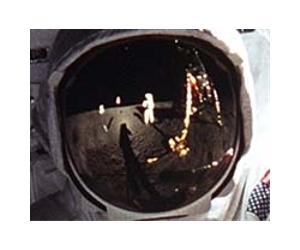By Amy CoopesSydney, Australia (AFP) Aug 29, 2011
http://www.space-travel.com/reports/Armstrong_relives_historic_Moon_landing_999.html
 a unique moment in time a unique moment in time |
It's more than 40 years since Neil Armstrong became the first man to walk on the Moon, but his memories of the historic flight remain as undimmed as his passion for further exploration of space.
The Apollo 11 commander, now aged 81, relived the 1969 mission that enthralled the world as he watched Google's new high-definition images of the Moon in Australia last week.
The pictures, available on YouTube since May but which Armstrong said he had only just seen, show Apollo 11's landing spot, including the fuel cell left behind which it also used as a launch pad.
"So for the sceptics about whether we ever landed on the Moon -- this is a pretty good indication that somebody's done it," he quipped to a business audience that had paid hundreds of dollars to hear him speak.
The famously private astronaut provided a rare glimpse into the flight, recalling the moment he hurtled free of Earth's gravity at "more than 10 times the speed of a rifle bullet".
"You're looking down at Asuncion Island in the Atlantic at dusk, and you soon fly into darkness," he said.
"You see some city lights on the African coast and notice lightning flashes illuminating some thunderheads like neon mushrooms far below you."
Crossing over to the daylight side of Earth he said a "scimitar of light" became a flood, blinding in its brightness, and though minutes passed by swiftly "you seem to be perfectly motionless".
"You look at Malaysia and the islands of Indonesia below, they're dropping away from you six or 8,000 kilometres per hour they're dropping away," he said.
"The horizon is growing more and more, you can see Australia off to the right and Japan off to the left, and all of a sudden you can see the entire circle -- the whole planet Earth, kind of a gigantic blue medicine ball covered with white lacy clouds, and it's floating slowly away from you into the inky black sky."
Playing the new high-definition pictures of the Moon alongside the original July 1969 Apollo footage, Armstrong recalled his arrival on the desolate, cratered landscape and the historic phrase relayed back to Earth: "Tranquility Base here, the Eagle has landed."
But he was also forward looking, telling the audience that the American space programme was "in some chaos".
As the United States contemplates the future of its space programme following the end of the shuttle era last month, he said NASA should start using the Moon for training missions for Mars exploration.
"I do favour going to Mars but I believe it is both too difficult and too expensive with the technology we have available at the current time," he told those gathered in Sydney.
"I favour returning to the Moon. We made six landings there and explored areas as small as a city lot and perhaps as large as a small town. That leaves us some 14 million square miles that we have not explored."
Armstrong also reflected at length on the Apollo programme and Americas space race with Russia.
It was a sometimes desperate and very close contest, he said, with the Soviets unmanned Luna 15 racing neck-and-neck for the lunar surface with Apollo 11 after an ambitious John F. Kennedy had set a deadline of 1970 for the United States to land on the Moon almost a decade earlier.
The Soviet craft's landing gear failed as it approached the Moon and it crashed into the surface, while Armstrong hoisted the American flag to "reach a goal that dreamers had been dreaming of for many, many centuries".
After Apollo 11, Armstrong said five more lunar spacecraft and 10 astronauts landed on the Moon, with the experiments completed there and samples returned multiplying mankinds knowledge of its closest neighbour "one thousand-fold".
"We understood the substantial risks, we were willing to accept them because we believed that our goal was a worthy goal," he said.
"I was fortunate enough to be led by men who made me yearn for the vast and endless sea above the surface of the Earth, and I am in their debt."